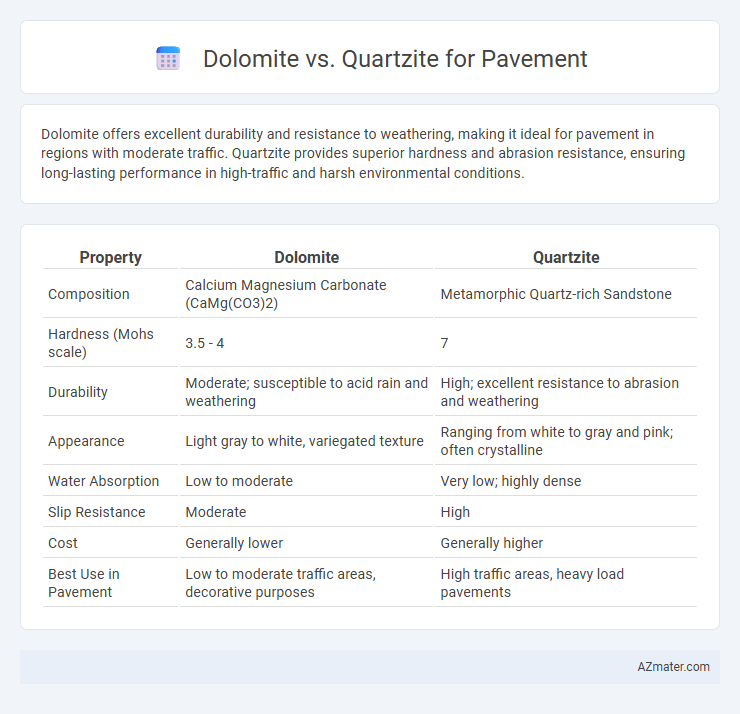Dolomite offers excellent durability and resistance to weathering, making it ideal for pavement in regions with moderate traffic. Quartzite provides superior hardness and abrasion resistance, ensuring long-lasting performance in high-traffic and harsh environmental conditions.
Table of Comparison
| Property | Dolomite | Quartzite |
|---|---|---|
| Composition | Calcium Magnesium Carbonate (CaMg(CO3)2) | Metamorphic Quartz-rich Sandstone |
| Hardness (Mohs scale) | 3.5 - 4 | 7 |
| Durability | Moderate; susceptible to acid rain and weathering | High; excellent resistance to abrasion and weathering |
| Appearance | Light gray to white, variegated texture | Ranging from white to gray and pink; often crystalline |
| Water Absorption | Low to moderate | Very low; highly dense |
| Slip Resistance | Moderate | High |
| Cost | Generally lower | Generally higher |
| Best Use in Pavement | Low to moderate traffic areas, decorative purposes | High traffic areas, heavy load pavements |
Introduction to Dolomite and Quartzite
Dolomite is a sedimentary carbonate rock composed primarily of the mineral dolomite, valued for its durability and resistance to weathering, making it suitable for pavement applications. Quartzite is a metamorphic rock formed from sandstone, characterized by its hardness, high silica content, and excellent resistance to abrasion, providing long-lasting pavement surfaces. Both materials offer distinct properties that influence their performance and selection in pavement construction projects.
Geological Formation and Composition
Dolomite forms through the diagenetic alteration of limestone, primarily composed of calcium magnesium carbonate, exhibiting a crystalline structure with significant magnesium content. Quartzite originates from the metamorphism of pure quartz sandstone, resulting in a dense, hard rock dominated by interlocking quartz grains. These geological formations give dolomite moderate hardness and chemical resilience, while quartzite offers superior durability and abrasion resistance for pavement applications.
Physical Properties Comparison
Dolomite exhibits high hardness with a Mohs rating of 3.5-4, offering good resistance to abrasion but is less durable than quartzite, which ranges from 7 to 8 on the Mohs scale and provides superior toughness and weather resistance. Quartzite's dense, non-porous structure enhances its compressive strength, typically exceeding 15,000 psi, making it ideal for heavy traffic pavement applications, whereas dolomite's compressive strength is lower, usually around 8,000-10,000 psi. The moisture absorption rate of quartzite is minimal, reducing freeze-thaw damage risks compared to the more porous dolomite, which tends to absorb water and degrade faster under harsh environmental conditions.
Durability and Weather Resistance
Dolomite offers moderate durability and good weather resistance, making it suitable for low to medium traffic pavements with reasonable exposure to environmental conditions. Quartzite exhibits superior durability and exceptional weather resistance due to its hardness and dense crystalline structure, making it ideal for high-traffic pavements exposed to harsh weather. The higher silica content in quartzite contributes to its enhanced resistance against abrasion and chemical breakdown compared to dolomite.
Aesthetic Appeal and Color Options
Dolomite offers a subtle, earthy palette with hues ranging from light gray to soft green, providing a natural and understated aesthetic for pavement applications. Quartzite stands out with its vibrant color options, including shades of white, pink, and blue, delivering a more striking and dynamic appearance. Both materials maintain durability, but quartzite's broader color spectrum allows for greater customization in design projects.
Installation and Maintenance Requirements
Dolomite pavement requires careful installation due to its susceptibility to weathering and periodic sealing for durability, while quartzite demands precise cutting and skilled labor but offers superior hardness and resistance to abrasion. Maintenance for dolomite involves regular cleaning and resealing to prevent surface degradation, whereas quartzite pavement benefits from minimal upkeep, primarily occasional washing and sealing to maintain its natural luster. The installation complexity of quartzite is offset by its longevity and reduced long-term maintenance costs compared to dolomite.
Environmental Impact and Sustainability
Dolomite and quartzite differ significantly in environmental impact and sustainability when used for pavement. Quartzite, being a harder and more durable natural stone, requires less frequent replacement, reducing resource consumption and waste over time. Dolomite, while abundant and locally available in some regions, may involve higher carbon emissions during extraction and processing, leading to a greater environmental footprint compared to quartzite's longer lifespan and lower maintenance needs.
Cost Analysis: Dolomite vs Quartzite
Dolomite pavement generally offers a lower initial cost compared to quartzite due to its abundant availability and easier extraction processes. Quartzite, while more expensive upfront, provides superior durability and resistance to wear, potentially reducing long-term maintenance expenses. Evaluating total lifecycle costs reveals that quartzite may yield better value in high-traffic areas despite its higher initial investment.
Best Applications for Pavement Projects
Dolomite, with its greater porosity and slightly lower hardness, is ideal for pavement projects requiring better water drainage and moderate durability, such as sidewalks and residential driveways. Quartzite's superior hardness and abrasion resistance make it best suited for high-traffic areas like highways, airport runways, and industrial pavements where long-lasting performance under heavy loads is critical. Selecting between Dolomite and Quartzite depends on the specific pavement project requirements including traffic intensity, weather resistance, and maintenance needs.
Conclusion: Choosing the Right Stone
Dolomite offers excellent durability and resistance to weathering, making it suitable for pavements in moderate traffic areas, while quartzite provides superior hardness and abrasion resistance, ideal for high-traffic and industrial environments. The choice between dolomite and quartzite depends on factors such as load-bearing capacity, budget constraints, and aesthetic preferences. For long-lasting pavement solutions, quartzite is preferred where maximum strength is required, whereas dolomite is a cost-effective alternative for less demanding applications.

Infographic: Dolomite vs Quartzite for Pavement
 azmater.com
azmater.com